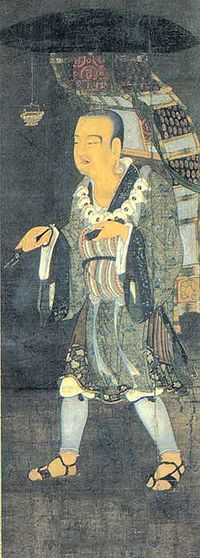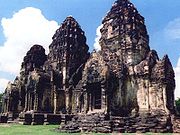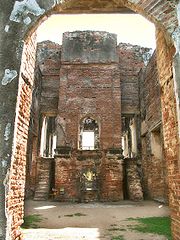
Lavo
Encyclopedia

Lopburi Province
Lop Buri is one of the central provinces of Thailand. Neighboring provinces are Phetchabun, Chaiyaphum, Nakhon Ratchasima, Saraburi, Phra Nakhon Si Ayutthaya, Ang Thong, Sing Buri and Nakhon Sawan.-Geography:...
is one of the most important cities in the history of Thailand
Thailand
Thailand , officially the Kingdom of Thailand , formerly known as Siam , is a country located at the centre of the Indochina peninsula and Southeast Asia. It is bordered to the north by Burma and Laos, to the east by Laos and Cambodia, to the south by the Gulf of Thailand and Malaysia, and to the...
. The city has a long history, dating back into the prehistory period since the bronze age
Bronze Age
The Bronze Age is a period characterized by the use of copper and its alloy bronze as the chief hard materials in the manufacture of some implements and weapons. Chronologically, it stands between the Stone Age and Iron Age...
of more than 3,500 years ago.
Later, it was influenced by the art and culture of India in the 11th century when it entered the historical era. This first period under the influence of Indian culture was called the Dvaravati Period. Since that time, Lavo has been ruled by the Khmer, coming under the influence of their art and culture, in the 15th century, a time commonly called the Lopburi Period in Thai art
Thai art
Traditional Thai art is primarily composed of Buddhist art. Traditional Thai sculpture almost exclusively depicts images of the Buddha. Traditional Thai paintings usually consist of book illustrations, and painted ornamentation of buildings such as palaces and temples.-Painting:Traditional Thai...
history.
Eventually, when the Ayutthaya empire was established, Lavo decreased in importance until the reign of King Narai the Great. He had a palace built in Lavo, and each year spent most of his time there. After the time of King Narai the Great, Lavo had been abandoned, until the 19th centuries, King Mongkut (Rama IV) had it restored to be used as an inland royal city.
Later, in the 20th century, Prime Minister Marshal P. Piboolsongkhram developed Lopburi to be a national military center.
Location
Lavo is located in central Thailand at a river named "Talae Chubshorn", which descends from the mountains "Sam-Yod" (Khao Sam Yod) above the city, and runs into Lopburi riverLopburi River
The Lopburi River is a tributary of the Chao Phraya River in central Thailand. It splits from the Chao Phraya river at Tambon Bang Phutsa, Singburi. Passing through Tha Wung district and the town of Lopburi, it enters the Chao Phraya together with the Pa Sak River at the town of Ayutthaya. It is...
at the west of the city. This river runs into Chao Phraya river in Singburi province.
Prehistorical era

Bronze
Bronze is a metal alloy consisting primarily of copper, usually with tin as the main additive. It is hard and brittle, and it was particularly significant in antiquity, so much so that the Bronze Age was named after the metal...
age. A lot of abandoned ancient cities with many pre-historic instruments and human skeletons has been found in several parts of the modern-day province.

Taxila
Taxila is a Tehsil in the Rawalpindi District of Punjab province of Pakistan. It is an important archaeological site.Taxila is situated about northwest of Islamabad Capital Territory and Rawalpindi in Panjab; just off the Grand Trunk Road...
(Takkasila) in Northwest India (now Pakistan) in 648 AD. According to the Thai records, King Kakabatr from Taxila
Taxila
Taxila is a Tehsil in the Rawalpindi District of Punjab province of Pakistan. It is an important archaeological site.Taxila is situated about northwest of Islamabad Capital Territory and Rawalpindi in Panjab; just off the Grand Trunk Road...
(believed to be one of the ancient cities in northern Thailand) set the new era, Chulasakaraj in 638. This era is favourite in region until now. His son, King Kalavarnadishraj founded this city in a decade later. And several years later he assigned Jamadevi
Jamadevi
Queen Jamadevi , also known as Nang Chamthewi of Hariphunchai, Channa Devi or Channadevi .First ruler of the Mon kingdom of Hariphunchai . She gave birth to twins, one of whom succeeded her as ruler of Lamphun Queen Jamadevi (Thai: พระนางจามเทวี) (Pali: Camadevi), also known as Nang Chamthewi of...
to reign the throne of Haribhunjaya kingdom in the northern Thailand.
These kingdoms adopted Indian culture together with Theravada Buddhism and grew up under the post Indian (the local technology that adapt from Indian) and Mon influence in the 11th to 12th centuries, as it entered into the historical era. This first period under the influence of Indian culture was called the Dvaravati
Dvaravati
The Dvaravati period lasted from the 6th to the 13th centuries. Dvaravati refers to both a culture and a disparate conglomerate of principalities.- History :...
period. For the time being this kingdom was known as Saruka Lavo (Mon language
Mon language
The Mon language is an Austroasiatic language spoken by the Mon, who live in Burma and Thailand. Mon, like the related language Cambodian—but unlike most languages in Mainland Southeast Asia—is not tonal. Mon is spoken by more than a million people today. In recent years, usage of Mon has...
). Although the inscription stones found in this area are the Mon language, however there is not clear evidence to prove if the population of Lavo were actually of Mon ethnicity.
Lavo in Chinese records

Tang Dynasty
The Tang Dynasty was an imperial dynasty of China preceded by the Sui Dynasty and followed by the Five Dynasties and Ten Kingdoms Period. It was founded by the Li family, who seized power during the decline and collapse of the Sui Empire...
(618–907), and another during the Song Dynasty
Song Dynasty
The Song Dynasty was a ruling dynasty in China between 960 and 1279; it succeeded the Five Dynasties and Ten Kingdoms Period, and was followed by the Yuan Dynasty. It was the first government in world history to issue banknotes or paper money, and the first Chinese government to establish a...
(960–1279). The Tang Chronicles refer to Lavo and Dvaravati as Tou-ho-lo. The diary of the monk Xuanzang
Xuanzang
Xuanzang was a famous Chinese Buddhist monk, scholar, traveler, and translator who described the interaction between China and India in the early Tang period...
, dating from the same period (629–645), also mentions the region, referring to it as Tou-lo-po-ti.
Lavo sent tributes to Song dynasty
Song Dynasty
The Song Dynasty was a ruling dynasty in China between 960 and 1279; it succeeded the Five Dynasties and Ten Kingdoms Period, and was followed by the Yuan Dynasty. It was the first government in world history to issue banknotes or paper money, and the first Chinese government to establish a...
twice, in 1115 and 1155. The Song Chronicles mention Lavo at that time as Lo Hu.
Marco Polo
Marco Polo
Marco Polo was a Venetian merchant traveler from the Venetian Republic whose travels are recorded in Il Milione, a book which did much to introduce Europeans to Central Asia and China. He learned about trading whilst his father and uncle, Niccolò and Maffeo, travelled through Asia and apparently...
's writings also refer to Lavo, as Locak. It was described as being located on the hinterland of Chao Phraya basin, a place too far to be subject to attack by the Kublai Khan
Kublai Khan
Kublai Khan , born Kublai and also known by the temple name Shizu , was the fifth Great Khan of the Mongol Empire from 1260 to 1294 and the founder of the Yuan Dynasty in China...
's army of Yuan
Yuan Dynasty
The Yuan Dynasty , or Great Yuan Empire was a ruling dynasty founded by the Mongol leader Kublai Khan, who ruled most of present-day China, all of modern Mongolia and its surrounding areas, lasting officially from 1271 to 1368. It is considered both as a division of the Mongol Empire and as an...
(1271–1368).
Khmer era

Khmer language
Khmer , or Cambodian, is the language of the Khmer people and the official language of Cambodia. It is the second most widely spoken Austroasiatic language , with speakers in the tens of millions. Khmer has been considerably influenced by Sanskrit and Pali, especially in the royal and religious...
). Lavo was subordinate to Khmer empire
Khmer Empire
The Khmer Empire was one of the most powerful empires in Southeast Asia. The empire, which grew out of the former kingdom of Chenla, at times ruled over and/or vassalized parts of modern-day Laos, Thailand, Vietnam, Burma, and Malaysia. Its greatest legacy is Angkor, the site of the capital city...
that rapid rise to prominence by the migration of Kambojas from the south India, therefore Lavo often be mentioned as Kambojarat (rat – kingdom) in some old Thai records. (Kambojas
Kambojas
The Kambojas were a kshatriya tribe of Iron Age India, frequently mentioned in Sanskrit and Pali literature.They were an Indo-Iranian tribe situated at the boundary of the Indo-Aryans and the Iranians, and appear to have moved from the Iranian into the Indo-Aryan sphere over time.The Kambojas...
, in this case, the Khmers of Cambodia) came with the influence of their art and culture, in the 15th to 16th centuries. The new constructions were made by the rocks onto the ruined Dvaravati holy place that made by the bricks without mortar, therefore the oldest ruins that can now be found in Lopburi always be the Khmer style on the Dvaravati foundation.
Ayudhya era

Ayutthaya kingdom
Ayutthaya was a Siamese kingdom that existed from 1350 to 1767. Ayutthaya was friendly towards foreign traders, including the Chinese, Vietnamese , Indians, Japanese and Persians, and later the Portuguese, Spanish, Dutch and French, permitting them to set up villages outside the walls of the...
kingdom was founded by King Ramadhibodi-I
Ramathibodi I
Uthong or Ramathibodi I was the first king of the kingdom Ayutthaya , reigning from 1351 to 1369. He was known as Prince U Thong before he ascended to the throne on March 4, 1351...
, which merged Lavo with the kingdom ruled from Subharnaburi
Suphanburi
Suphan Buri is a town in central Thailand, capital of the Suphan Buri Province. It covers the whole tambon Tha Philiang and parts of the tambon Rua Yai and Tha Rahat, all within the Mueang Suphan Buri district...
called Subharnabhumi or Pan Pum, which according to the common Thai history to be identical with the Suvarnabhumi
Suvarnabhumi
Suvarnabhumi or Suvannabhumi meaning the "Golden Land" or "Land of Gold", is a term coined by the ancient Indians which refers broadly to Lower Burma, Lower Thailand, Lower Malay Peninsula, the Sumatra, but more generally accepted to refer more specifically to Lower Burma...
kingdom. This event had been recorded in the Chinese texts that called Thai as Xian-lo-guo or Siam-Lavo-country.
At that time Lavo became a "Mueang
Mueang
Mueang were historical semi-independent city-states or principalities in present-day Thailand, Laos, parts of northern Vietnam and the Shan State of Myanmar. Smaller Mueang were subordinate to more powerful neighboring Mueang, which in turn were subordinate to the central king, as described in...
Luk Luang", an important city ruled by a crown prince for a several years in the beginning of Ayudhya period. There were not any evidences the prosperity of Lavo was transferred from Lavo to Ayudhaya, but with time Lavo decreased in importance to become only a border town to the north of Ayudhaya.
In the reign of King Narai
Narai
Somdet Phra Narai or Somdet Phra Ramathibodi III was the king of Ayutthaya from 1656 to 1688 and arguably the most famous Ayutthayan king. His reign was the most prosperous during the Ayutthaya period and saw the great commercial and diplomatic activities with foreign nations including the...
the Great, the 26th king of Ayuadhya, in the mid of the 17th century it raised again. He commanded to reconstruct the palace at the same place of King Ramesavara
Ramesuan
King Ramesuan , son of king Ramathibodi I, reigned as the second and fifth king of the kingdom of Ayutthaya. When King Ramathibodi ascended to the throne of Ayuthaya, he sent King Ramesuan to reign in Lopburi...
's Palace as a summer palace, King Narai's Palace
King Narai's Palace
The King Narai's Palace in Lopburi was built by King Narai the Great, the king who ruled Ayutthaya from 1656 to 1688. He ordered to build the palace in 1666 in the same area of King Ramesuan's Palace. King Narai stayed here for about 8-9 months a year, except rainy season...
in 1666. Lavo thus served as a second capital, next to Ayudhya, the king stayed here for about eight months a year.
Rattanakosin era
After the time of King Narai, Lavo had been abandoned, until King MongkutMongkut
Phra Bat Somdet Phra Poramenthramaha Mongkut Phra Chom Klao Chao Yu Hua , or Rama IV, known in foreign countries as King Mongkut , was the fourth monarch of Siam under the House of Chakri, ruling from 1851-1868...
(Rama IV) of Rattanakosin kingdom had it restored to be used as an inland royal city.
Lavo had also been renamed to Lopburi
Lopburi
Lopburi ) is the capital city of Lopburi Province in Thailand. It is located about 150 km north-east of Bangkok. As of 2006 it has a population of 26,500...
in this period.
Later, in 1937, Prime Minister Marshal P. Phibul Songkhram desired to set up Lopburi as the military center of Thailand. Therefore the city had been expanded. He relandscaped the Lopburi city, with its modern center located about 4 km. east from the historical center. His building style, Art Deco
Art Deco
Art deco , or deco, is an eclectic artistic and design style that began in Paris in the 1920s and flourished internationally throughout the 1930s, into the World War II era. The style influenced all areas of design, including architecture and interior design, industrial design, fashion and...
is showing along Narai Maharat road. The improvements he had made to the city are apparent even to the present day.

